High-quality printing is in more demand than ever in the fast-paced world of today. DTF printing is one of the most inventive printing techniques that have appeared recently. This printing technique transfers an image from a transfer film to the printing surface. Although the DTF process has revolutionised the printing business, the ink is generally forgotten. Do you know what type of ink is used in DTF printing? Understanding the various ink types used in DTF printing is crucial since they may have a considerable impact on the print’s quality, tenacity, and brightness.
In this post, we’ll look at the many kinds of ink used in DTF printing, the things to take into account while selecting ink, and how ink influences the quality of the outcome. To maximize print quality and printer life, we’ll provide DTF ink management and storage suggestions. Hence, continue reading to find out more about how crucial ink is to DTF printing!
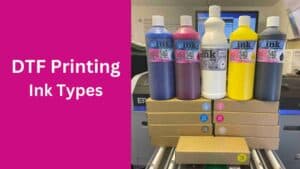
What is DTF ink?
DTF ink is used in Direct-to-Film (DTF) printing, a digital printing method that transfers ink onto a film or transparent transfer sheet and subsequently onto a substrate like cloth or solid surfaces. You can use it with particular DTF printers and substrates and comes in solvent, water, and sublimation-based formulations.
What is DTF ink made of?
DTF ink contains pigments, resins, and other ingredients that attach to a variety of surfaces and create brilliant, long-lasting prints. Depending on the ink type and application, the precise composition of DTF ink might change, however the following are some of the standard ingredients:
- Pigments: Colored pigments are used in DTF ink to give the ink its colour and opacity. Carbon black, titanium dioxide, and other chemical and inorganic substances are used to make pigments.
- Resins: Resins are binders that keep the pigments in the DTF ink together and help it adhere to the substrate. Acrylic, urethane, and vinyl resins are often included in ink.
- Additives: Additives increase DTF ink flow, viscosity, and drying time. Additives include thickeners, surfactants, and drying agents.
- Solvents: Solvent-based DTF ink helps dissolve pigments and resins and flow. Ink type and application determine solvent type and volume.
| Image | Product | Features | Price |
|---|---|---|---|
FOR EPSON PRINTERS  | CenDale Premium DTF Ink 600ML
| 9.9 | Check on AmazonGet 1200ml Pack |
ALL DTF PRINTERS  | Welacer DTF Ink Premium 6x100ml
| 9.8 | Check on Amazon10% Coupon |
AMAZON’S CHOICE  | Enlite DTF Ink 250ML Combo Pack
| 9.6 | Check on AmazonGet 500ml Pack |
WATERPROOF  | LOTSA. STYLE Premium DTF Ink
| 9.5 | Check on Amazon |
EPSON PRINTERS REFILL  | Greenland Office DTF Ink Premium 600ml
| 9.3 | Check on Amazon10% Coupon |
FOR ALL DTF PRINTERS  | Jecqbor DTF Transfer Ink
| 8.9 | Check on Amazon25% Coupon |
Types of Ink Used in DTF Printing
Let’s see what kind of ink is used for DTF printing.
Pigment Ink
One of the ink kinds utilised in DTF printing is pigment ink. Pigment inks include microscopic, solid pigment particles in a liquid carrier. It forms a coating of colour on the substrate, unlike dye-based inks, which dissolve in liquid and soak into it.
Pigment ink is a great option for printing on materials that will be exposed to sunshine, heat, or moisture because of its strength and resistance to fading. You can use this ink type for printing high-quality photographs, graphics, and artwork since it reproduces colours vividly.
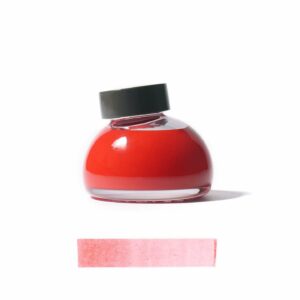
This ink generates bright, crisp, high-contrast prints. Since ink particles reside on top of the substrate, printing is more precise and controlled. Pigment ink prints on cloth, paper, and plastic without bleeding or smudging.
Pigment ink has limitations too in DTF printing. This ink is more costly and requires a stronger printer to print well. In certain situations, the ink particles sitting on top of the substrate might generate a small roughness on the substance.
Overall, pigment ink is a great option for printing sharp, long-lasting graphics, photos, and artwork. Textile, fine art, and picture printing use it because to its fade resistance and rich colour reproduction.
Sublimation Ink
The DTF printing process also uses sublimation ink. Sublimation ink, unlike pigment ink, is dye-based and bonds with polyester materials by sublimation.
Sublimation ink offers vivid, rich colours that resist fading and breaking, making it useful for printing on polyester. When exposed to high temperatures, the heat-sensitive dye molecules in sublimation ink will transform from a solid to a gaseous state. This bonds the dye to the polyester strands, creating a permanent, full-color print that won’t peel, fracture, or fade.

This ink type generates a soft, flexible print that doesn’t add weight or rigidity. This makes it the perfect option for printing on breathable, light textiles used in athletics, activewear, and performance clothing.
DTF printing using sublimation ink has significant drawbacks. Sublimation ink is only appropriate for polyester materials. For correct colour reproduction, the cloth must be white or light-colored because the dye molecules must connect with the polyester strands.
Overall, sublimation ink is a great option for producing vibrant, long-lasting prints on polyester materials. Sports gear, promotional goods, and customised gifts use it because to its brilliant colours and smooth, flexible feel.
Solvent Ink
In DTF printing, solvent ink is a kind of ink used to dissolve into a solvent carrier, which then evaporates when the ink dries. As a result, a coating of colour is left on the substrate’s surface, that translates into a robust and long-lasting print.
Solvent ink is great for printing vinyl banners, car wraps, and outdoor signs because of its durability, water-resistance, and scratch-resistance. Industrial printing on metal or plastic surfaces uses it too.
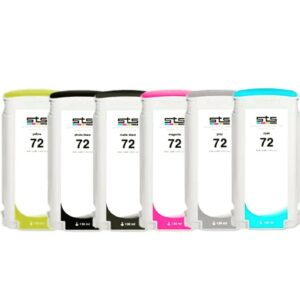
Its adaptability is one of its key benefits. You can apply it to a variety of surfaces, including metal, glass, ceramic, vinyl, PVC, and other plastics. Solvent ink furthermore creates a premium, glossy surface perfect for outdoor advertising and promotional products.
But, solvent ink in DTF printing has significant downsides. While printing, solvent ink may release harmful fumes, thus ventilation and safety gear are essential. Solvent ink may need specific handling and disposal to protect the environment.
Solvent ink is a great option for printing tough, long-lasting images on a variety of surfaces. Its flexibility and durability make it a popular option for outdoor advertising and industrial printing, but its toxicity and environmental effect may limit its use.
How Ink Affects DTF Printing Quality?
Ink plays a significant part in defining the quality of DTF prints. Ink affects DTF printing quality in several ways:
- Color Accuracy: Ink quality influences DTF printing colour accuracy. High-quality ink with consistent pigments may generate more accurate, bright colors in prints.
- Opacity: Ink opacity affects how much of the substrate colour is visible through the ink. When printing on dark surfaces, high-opacity ink prevents substrate colour from seeping through and distorting the picture.
- Durability: The durability of DTF transfers are mostly affected by the quality of the ink used. Inks that are resistant to fading, cracking, and peeling are vital for generating long-lasting prints that can survive wear and tear.
- Adhesion: The adherence of ink to the substrate is crucial to generating crisp, high-quality prints. Ink that does not adhere effectively to the substrate might result in smearing or partial prints.
- Curing: It’s all about drying and hardening the ink after printing. Ink that does not cure correctly might result in poor-quality prints that are prone to smearing or fading over time.
Factors to Consider When Choosing Ink for DTF Printing
To achieve the finest results possible when selecting ink for DTF printing, you need to take into account a number of things. These factors comprise of:
- Compatibility with substrate: The kind of ink you choose is significantly influenced by the substance you want to print on. Some inks are made for cloth, plastic, or metal, while others are more adaptable. The improper kind of ink might cause smudging, poor adhesion, and other problems that can ruin your print.
- Color vibrancy and accuracy: Ink quality affects print colour vibrancy and accuracy. Higher-quality inks produce brighter, more vivid colours that are less prone to fade over time. When printing designs with precise colour requirements, it’s critical to use an ink that provides accurate, consistent colours.
- Durability and resistance: Certain applications need ink that resists fading, breaking, and peeling. For instance, an ink that can survive exposure to the outdoors without losing its colour or clarity is necessary if you’re printing outdoor signs. If you’re printing on materials that you will wash or wear, you’ll need an ink that will withstand repeated usage.
- Environmental concerns: Solvent-based inks may damage the environment and need specific handling and disposal. Where feasible, use an ink that is waste-free and is beneficial to the environment. This protects the environment and saves money by decreasing disposal expenses and regulatory penalties.
- Compatibility with your printer: Lastly, it’s critical to choose an ink that works with your DTF printer. When making a purchase, it’s crucial to read the manufacturer’s recommendations since certain printers are designed to only function with particular kinds of ink. In addition to creating prints of low quality, using the incorrect ink might harm your printer and violate your warranty.
Best Practices for Handling and Storing DTF Ink
DTF ink needs proper handling and storage to operate well. The following are some recommended handling and storage techniques for DTF ink:
Control of temperature and humidity: You should keep DTF ink in a cool, dry area with constant temperatures and levels of humidity. Severe temperature or humidity variations might affect ink performance and consistency.
Prevent exposure to light: DTF ink pigments may fade or break down when exposed to UV or direct sunshine. Avoid direct light and keep DTF ink in a dark or opaque container. Before using DTF ink, shake it vigorously to spread the pigments.
Maintain a clean workspace: Dust, grime, and other ink remnants may degrade the quality of DTF prints. To avoid contamination, it’s critical to handle and transfer ink using clean tools and equipment.
Unused ink disposal: Local laws require appropriate disposal of unwanted or expired ink. Never flush ink down the toilet or discard it in the garbage.
Examine expiry dates: DTF ink has a shelf life, thus it’s crucial to do so before using the ink. Using expired ink might reduce its durability and efficacy.
How long does DTF ink last?
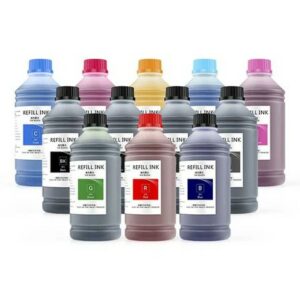
DTF ink lifetime depends on formulation, storage, and use. DTF ink typically has a shelf life of 12 to 24 months when maintained properly, such as in a cool, dry location away from UV or direct sunlight.
Before using ink, verify its expiry date. The longevity of printer ink depends on variables including frequency of usage, printer maintenance, and printing circumstances.
DTF ink can create high-quality prints for many months to a year or longer with appropriate care and use. But, if the ink is not properly cared for or kept, it may dry up, clog the printhead nozzles of the printer, and have a shorter lifetime.
Is DTF ink the same as sublimation ink?
No, DTF ink and sublimation ink are not the same. While people use both kinds of ink in digital printing, their characteristics and intended uses vary.
DTF ink is printed onto a specific film and heat-pressed onto the final substrate for direct-to-film printing. The pigments, resins, and other additives that ink normally includes, cling to a variety of surfaces and create vivid, long-lasting prints.
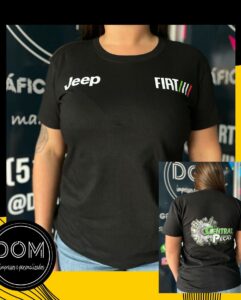
Contrarily, dye-sublimation printing uses sublimation ink, which is printed on transfer paper before being heated up and transferred to a polyester or other synthetic material substrate. Sublimation ink comprises dyes that sublimate or evaporate under heat and pressure and link with polyester fibres to create a high-quality, permanent print.
Can I use sublimation ink for DTF printing?
Sublimation ink is not advised for DTF printing since the two kinds of ink have distinct qualities and are made for various printing techniques. DTF ink is intended for direct-to-film printing onto a release liner and transfer to the final substrate, whereas sublimation ink works with sublimation transfer paper and polyester or polymer-coated substrates.
Sublimation ink for DTF printing may not bind with the film or transfer to the final substrate, resulting in poor ink adherence, colour transfer, and image quality. Sublimation ink is less opaque than DTF ink, which may reduce coverage and colour vibrancy on dark surfaces.
Using premium DTF ink that is optimized especially for your printer and substrate will help you get the greatest results from DTF printing. This will help you get the best prints possible and ensure appropriate ink adherence, colour brightness, and durability.
Can you mix DTF ink?
Most of the time, it’s not a good idea to mix different types or brands of DTF ink, as this can lead to unexpected results and could cause problems with how well the inks work together and stick.
Mixing inks may change their colour, viscosity, and drying time, which can influence print quality and durability. Use high-quality, compatible DTF ink developed for DTF printing and follow the manufacturer’s instructions.
Conclusion – DTF Printing & Role of ink
In conclusion, DTF printing has grown to be a well-liked and adaptable printing technique, providing a number of advantages and benefits over other conventional printing techniques.
DTF printing uses pigment, sublimation, and solvent-based inks, depending on the work, to produce high-quality results. You can avoid clogging and other problems that may occur while using ink with proper handling, storage, and circulation. It can produce high-quality, bright, and long-lasting prints by knowing DTF ink qualities and best practices.
FAQs
Depending on the particular ink composition, DTF ink can be either water-based or solvent-based.
DTF ink is a mix of pigments or dyes, resin, and other additives; the exact ingredients might change depending on the manufacturer and the composition of the ink.
Yes, DTF printing requires special ink that works with polyester-based transfer film and other needs.
In some aspects, DTF ink is comparable to inkjet ink. It is designed to be sprayed onto a surface using inkjet printheads. It is created expressly to meet the needs of the printing process, however.
Undoubtedly, white ink is often used in DTF printing as a base layer. This layer is printed initially and acts as a foundation for later layers of colour.
DTG ink is good for direct-to-garment printing on fabric, whereas DTF ink is suitable for printing on transfer film.
DTF ink usually contains pigments or dyes, resin, surfactants, humectants, and preservatives.

Ashley Wang is a skilled sales manager with knowledge in DTF printing. She presently works for ShenLan Digital, a reputable DTF printer maker. Ashley is the best person to offer advice on selecting the most suitable DTF printer because she has tested a lot of them. She launched DTFPrinterSchool to educate individuals and organisations about DTF printing technology, providing her expertise and observations on the most recent advancements in the sector. Ashley is an invaluable resource for businesses and individuals wishing to invest in DTF printing technology because of her expertise and experience in the industry.
